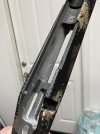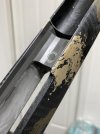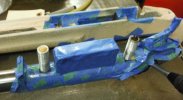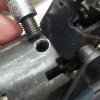muleystalker
Well-Known Member
Remember Johnson's paste wax on everything, inside screw holes, action and all! Next put oil base modeling clay in the action screw holes and all others, the clay will push up into the action instead of the beading compound. If a tiny bit does get in the action leaves it and let it cure, it will be easier to get out if you don't mess with it, it will give you a little bearing surface to tap with a. Brass punch. Plus a little heat is your friend for a stubborn piece. Remember Benchrest shooters and some F-Class shooters epoxy their actions into their stocks, a little heat and they pop richt out. But wax and a little piece of clay will realy make hinge easier. And try and get the top of the beading between the stock and action cleaned up and nice and level, it saves a lot of work after. I find that Brownells accugel or Devcon 10110 works much better and is a lot easier to work with. It's thicker and doesn't run all over like marinetex, it's easier to get a nice clean even line with the edge of the stock. This is one I did with Devcon 10110 steel putty.




